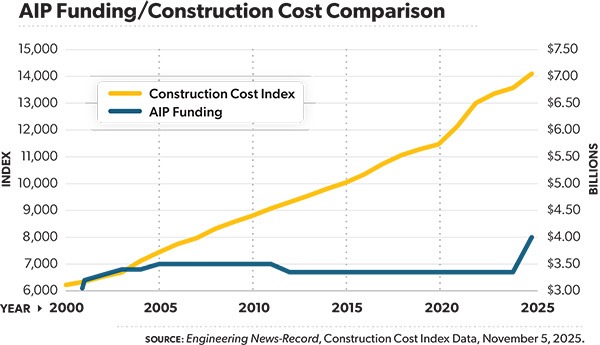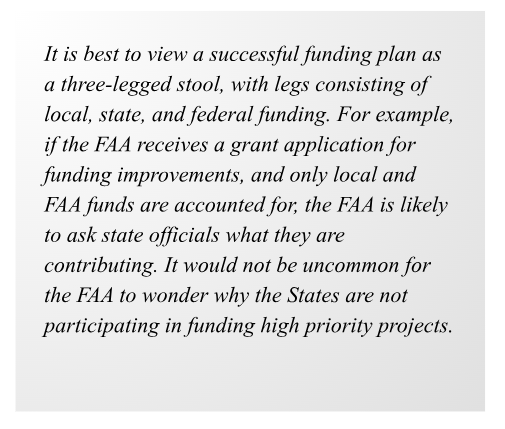By Tom Schauer, Senior Aviation Advisor, Mead & Hunt
Improvement projects at airports share some common characteristics with navigating aircraft—the outlook may be uncertain, visibility can be poor, or the weather, tumultuous, but one still needs to fly the aircraft. Airports are increasingly challenged by how to pay for needed improvements when funding is scarce, and the list of projects just grows longer.
Strategic approach to funding
Although federal funding has grown over the last 25 years, from $2 billion in 2000 to $4 billion in 2025, apportionment funds have been fairly stagnant for the past several years. With hundreds of airports nationwide competing for federal funding, local and state governments are increasingly expected to fill the gap. As a result, seeking funds is more politicized than ever. In this environment, a well-crafted political strategy is no longer optional—it is essential.
For example, we can look at construction costs over the same period. As shown, appropriation funds have not increased at a rate consistent with rising construction costs. In addition, annual aviation construction cost escalation continues to outpace general construction due to the heavily regulated nature of aviation development. Since an aviation-specific construction cost index was not available, we referred to the ENR data as a conservative benchmark for comparison.
 In the past, airports seeking federal funding focused on their project needs and the technical merits of those projects. Airports prioritized their projects and planned the program, then sought Airport Improvement Program grants to fund them. With available FAA funding being short of the construction needs, it has become more critical that the Federal Aviation Administration prioritize projects, and they may have to forego low priority projects. In their effort to prioritize projects, the Federal Aviation Administration wants to see which parties come to the table ready in support of the project.
In the past, airports seeking federal funding focused on their project needs and the technical merits of those projects. Airports prioritized their projects and planned the program, then sought Airport Improvement Program grants to fund them. With available FAA funding being short of the construction needs, it has become more critical that the Federal Aviation Administration prioritize projects, and they may have to forego low priority projects. In their effort to prioritize projects, the Federal Aviation Administration wants to see which parties come to the table ready in support of the project.
 Essentially, airports need to develop a political strategy for seeking funding if they do not already have one. This will mean considering your audience. Who are the decision-makers? What is their familiarity with airports and how they operate? What matters most to them or keeps them up at night—jobs, economic impact, community benefits, business connections, leisure destinations—all of the above? Do they see the value in having airports operating in their area? If not, how can an airport owner demonstrate the value it represents to the community, state, or air travel worldwide? Once a picture of the audience develops, then airports can work on anticipating the questions decision-makers might have before agreeing to fund the airport. This forethought helps to clarify how much money to ask for, why, and what investing that amount will do for not just the airport but the state and local communities also.
Essentially, airports need to develop a political strategy for seeking funding if they do not already have one. This will mean considering your audience. Who are the decision-makers? What is their familiarity with airports and how they operate? What matters most to them or keeps them up at night—jobs, economic impact, community benefits, business connections, leisure destinations—all of the above? Do they see the value in having airports operating in their area? If not, how can an airport owner demonstrate the value it represents to the community, state, or air travel worldwide? Once a picture of the audience develops, then airports can work on anticipating the questions decision-makers might have before agreeing to fund the airport. This forethought helps to clarify how much money to ask for, why, and what investing that amount will do for not just the airport but the state and local communities also.
Part of any good political strategy is the ability to persuade your audience, and the message needs to resonate with their interests. For example, discussions surrounding funding will involve highlighting the benefits the improvements offer relative to the implementation cost, but when funding constraints are involved, that discussion needs to address the full picture. Covering the project costs and investing in the airport are not necessarily viewed as the same thing.
Thinking strategically while planning development amid shrinking resources takes practice. Airports can benefit from helpful discussion with those who have successfully navigated the balance required for strategic communication about funding within political environment. The success of such strategies allowed six Mead & Hunt clients in the upper Midwest to receive in excess of $104M dollars of state funding for their projects, in addition to gaining notable amounts of both Infrastructure Investment and Jobs Act Airport Terminals Program funds and federal discretionary funding.
The simple truth in the aviation industry is that there will never be enough funding from a single source to cover all of the costs for both maintenance and improvements. In addition, the tried-and-true methods to seek funding in years past no longer hold as true. Instead, the savvy airport owner/operator needs to learn how to view funding needs as an exercise in political strategy. They must be prepared to gain the support of local, state, and federal entities to seek funds, and to encourage all of those entities to be a part of the solution. The three-legged stool can only hold the weight of the necessary projects if everyone is willing to contribute, and to achieve that kind of buy-in requires the willingness to think strategically and to advocate for your airport at every level of potential funding.
EDITOR’S NOTE: Tom Schauer has over 36 years of experience in the aviation industry, spending the first 26 years working at the FAA as an Airports District Office (ADO) Manager in the Great Lakes Region, Regional Compliance Officer, Regional Senior Engineer, and ADO Program Manager. More recently, Tom has worked in private industry helping clients garner public and governmental financial support for critical infrastructure needs. This includes the development of strategies that involve public outreach, briefing papers, presentations, coordination with the FAA at all levels, congressional briefings, and state government. As Tom likes to say, “A plan that can’t be funded is no plan at all.”